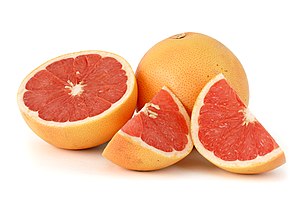Cookbook:Grapefruit
| Grapefruit | |
|---|---|
 | |
| Category | Fruits |
Cookbook | Recipes | Ingredients | Equipment | Techniques | Cookbook Disambiguation Pages | Ingredients | Citrus
The grapefruit is a large citrus fruit resulting from the cross between an orange and a pomelo.[1][2]
Characteristics
[edit | edit source]The fruits grow in clusters and are typically quite large. The thick peel is yellow-to-orange, with undertones that vary according to the variety.[3] Like that of other citrus fruits, the flesh is sour,[1] but it is also somewhat bitter due to the presence of a compound called naringin.[4] So-called white grapefruits have a green undertone and pale yellow flesh.[3][5] Pink grapefruits, as the name would suggest, have a light pinkish undertone to their skin and flesh.[3][5] Ruby or red grapefruits have a more orange-toned skin, and the inside is a deep pink-red color.[3][5] Some varieties have been bred for seedlessness.[2][3][5]
Selection and storage
[edit | edit source]When choosing grapefruit, look for varieties that are firm and heavy, with no spotting, discoloration, or soft spots.[1][6] Pointed ends may indicate a particularly thick peel with less flesh.[6] At room temperature, the fruit will keep for about 1 week post-purchase, and storing in the fridge will extend the lifetime to a month or two.[1][7] Grapefruits are said to be best served at room temperature.[7]
Use
[edit | edit source]Grapefruit is often served fresh,[3] especially as a breakfast fruit.[2] To serve a grapefruit in this way, first cut it in half right across the axis. A small spoon may then be used to scoop out the pulp. You may wish to first cut around the center or around the edge, possibly using a bent serrated knife. You may wish to use a grapefruit spoon. If the grapefruit is particularly sour, you might sprinkle some sugar on top.
The grapefruit juice may also be used for flavoring desserts and other cooked preparations, much in the way of other citrus fruits.[8] Likewise, it may be cooked into marmalade, and the peel may be candied.[8] Note that grapefruit juice will become increasingly bitter as it stands.[4]
Safety
[edit | edit source]Be aware that grapefruits contains a compound that interacts with drug processing in the body, so be sure to check with a physician before eating grapefruit if you are taking medication.[4]
Recipes
[edit | edit source]References
[edit | edit source]- ↑ a b c d Kipfer, Barbara Ann (2012-04-11). The Culinarian: A Kitchen Desk Reference. Houghton Mifflin Harcourt. ISBN 978-0-544-18603-3.
- ↑ a b c The Chefs of Le Cordon Bleu (2011-12-02). Le Cordon Bleu Patisserie and Baking Foundations. Cengage Learning. ISBN 978-1-4390-5713-1.
- ↑ a b c d e f The Culinary Institute of America (CIA) (2015-02-25). Baking and Pastry: Mastering the Art and Craft. John Wiley & Sons. ISBN 978-0-470-92865-3.
- ↑ a b c McGee, Harold (2007-03-20). On Food and Cooking: The Science and Lore of the Kitchen. Simon and Schuster. ISBN 978-1-4165-5637-4.
- ↑ a b c d Rinsky, Glenn; Rinsky, Laura Halpin (2008-02-28). The Pastry Chef's Companion: A Comprehensive Resource Guide for the Baking and Pastry Professional. John Wiley & Sons. ISBN 978-0-470-00955-0.
- ↑ a b Gisslen, Wayne (2015-03-12). Essentials of Professional Cooking, 2nd Edition. Wiley Global Education. ISBN 978-1-119-03072-0.
- ↑ a b Friberg, Bo (2016-09-13). The Professional Pastry Chef: Fundamentals of Baking and Pastry. Wiley. ISBN 978-0-470-46629-2.
- ↑ a b The Culinary Institute of America (CIA) (2011-09-13). The Professional Chef. John Wiley & Sons. ISBN 978-0-470-42135-2.
